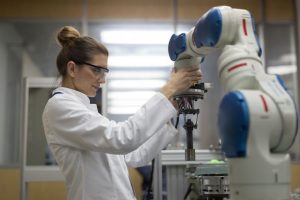At Automation Alley’s TECHTakeover I explored the future of manufacturing at the presentation on collaborative and autonomous robotics. The technology presented was astounding, and opened my “ergo eyes” to a whole new dimension for the field of ergonomics.
In ergonomics, there are four main risk factors for musculoskeletal disorders (MSDs); posture, force, frequency and duration. Humans have limitations, and these limitations are what create the MSD risk we so vigilantly try to combat. Robots, however, have different limitations and, lucky for humans, they are very capable of precision, endurance and power tasks.
Alongside humans, collaborative robots have the ability to help with machine tending, material handling, assembly tasks, packaging and inspection. They are uncaged, and ready to be our coworkers. With ISO/TS 15066 – Technical Standard for Collaborative Robot System Safety, adopted by ANSI/RIA, the safety requirements for collaborative robots make it possible for these interactions to occur. The robots are specifically designed to identify proximity and contact with their human counterpart, in response, lowering power and force to a level that will not cause harm to the human. Overall, this gives the human a chance to respond appropriately to both the robot’s and his own actions.
The important thing to remember when considering these robots is that they are highly-technical pieces of equipment. This means that a comprehensive risk assessment is required for implementation. Such risk assessments can also vary depending on the complexity of the robot and its power potentials. Depending on the complexity of the assessment required, there are different procedures necessary to carry out the assessment. Overall, to ensure operator safety, an assessment must be carried out upon implementation for every collaborative robot.
Autonomous robots, though quite different than collaborative robots, are also influencing the ergonomics world. I was amazed while I watched an autonomous robot navigate itself down a walkway through a busy room with human interaction, at Automation Alley’s TECHTakeover. Not only did it navigate the situation, it then stationed itself beside a collaborative robot that provided it a load, unto which the autonomous robot recognized and returned to drop off the load in its original location. By their ability to seemingly effortlessly transfer product through a facility, autonomous robots may be the answer to battle the high-force strains on operators when having to push, pull and carry product.
All in all, collaborative and autonomous robots seem to be creating a new world where manufacturers can give operators a coworker that is going to “take a load off”—both figuratively and literally.
